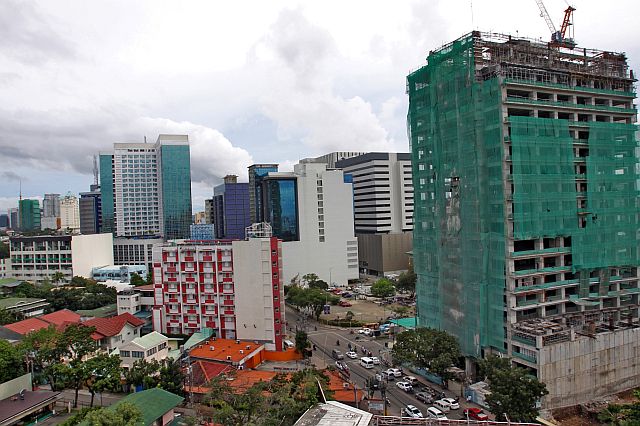
Cebu’s property future continues to be a bright spot for developers in the country as the construction boom continues, with experts predicting the industry’s growth in the next 10 years. (CDN PHOTO/JUNJIE MENDOZA)
(CONCLUSION)
Experts, developers see more opportunities for property sector in 2017
The construction boom in Cebu continues as more vertical and horizontal projects are being lined up for development this year.
Amid this development, a property expert has noted the maturity of the market while an official of a real estate firm has seen this year as the heyday of real estate in Cebu.
Jojo Salas, research director at Pinnacle Real Estate Consulting Services, Inc., said Cebu’s property market has reached its maturity and that the challenge for players now is to stay competitive.
For Pinnacle, “due diligence” means knowing where to go and what kind of property to develop.
Salas said they have constantly advised their clients that the “you will build and they will come” mentality is no longer acceptable at present, unlike in the past when developers raked in huge amounts of profit.
He said developers need to be more deliberate in terms of planning and targeting their market, especially now that the industry has become more competitive in terms of pricing and product.
Market overview
In its property market overview as of November 2016, Pinnacle saw robust performances in the office, residential, retail, and hotel markets, but placed greater confidence in Cebu’s industrial sector.
Salas said that the industrial zones in Metro Cebu, which is comprised of 13 towns and cities, were already filled up four years ago, well ahead of their counterparts in Luzon.
At present, Metro Cebu has 27 IT parks/centers, seven manufacturing zones, two tourism economic zones, and one agro-industrial economic zone.
Of the total area of economic zones estimated at 120 hectares, only less than three hectares of space are available for lease, reflecting an occupancy rate of 97.5 percent.
Available space
To address the limited available industrial space in Metro Cebu, an additional 50 hectares will be reclaimed for a light industrial park in Minglanilla town under a public-private partnership between the Philippine Reclamation Authority, the local government unit, and Cebu Landmasters.
The recently approved vertical socialized housing as well as the increase in price and loan ceiling for economy housing may further drive the boom in the residential sector, which saw a 148-percent growth in the number of condominium units sold in the last four years.
In terms of residential stock, the market now has approximately 22,284 condominium units while it only had about 9,026 in 2013. Furthermore, an average of 5,000 units will be delivered in the next couple of years.
On take up, the average is 5,000 units per year, which is to say that the projected increase may be comfortably absorbed by the market. Stable increase in prices also showed the sector’s soundness.
The average selling price in 2013 was around P84,000 per sq. m.; P90,000 per sq. m. in 2014; and in 2015, at P95,000 per sq. m. At present, the estimated average selling price is at P99,000 per sq. m., a growth of 18 percent from the 2013 level.
CEO’s take
For Beverly Dayanan, president and chief executive officer of Contempo Property Holdings, Inc. (CPHI), this kind of growth has never happened in the real estate industry before.
“It’s a heyday for real estate,” she said, adding that she foresees the industry to continue to flourish even in the next 10 years.
Dayanan anchored her confidence in the leadership of the present administration, with Duterte emphasizing the need for more low- to middle-class housing.
“Where our current administration would go, we would be very supportive of that effort,” she said.
Dayanan said that the drawback, however, is the continuing rise in the price of land, which is considered to be the biggest input of industry players.
“That is why we are strengthening our organization to move and expand our reach to Mindanao,” she explained.
Challenging year
Alexander Mañalac, chairman of the National Real Estate Association (NREA), however, said that 2016 had been very challenging.
“There are those that earned well, there are those that didn’t,” he said.
Mañalac said that 2017 will be exciting only for those that are properly positioned, especially those whose presence can be found online, while those that only “wait for blessings to come” will never prosper.
“Those who really chase these opportunities and know how to develop the system, build the network, these are the people who can survive and thrive in any situation,” he said.
More to be done
Efren Carreon, the National Economic and Development Authority Central Visayas (NEDA-7) director, said that while economic growth was necessary over the last five years, it was still not enough for poverty reduction.
“More need to be done to achieve inclusivity,” he said, adding that there should be more opportunities for those in the fishing and agriculture sectors since most of the country’s population rely on these industries.
Over the last five years, Central Visayas’ Gross Regional Development Product (GRDP) has grown by an average of 7.2 percent, which is short of the planning agency’s target of 7.5 percent.
Nonetheless, Carreon said he was confident the region will meet its target in the near and medium term due to the thrust of the current administration to bring development outside of the capital.